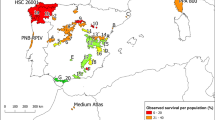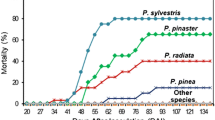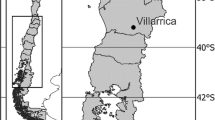Abstract
Pine wilt disease (PWD) affects forests globally and is caused by the pinewood nematode (PWN) Bursaphelenchus xylophilus. It has been proposed that PWD development has a strong association with air temperature. Because symptom development is related to the number of PWNs and they are poikilothermic animals whose development and multiplication are affected by temperature; it appears that temperature conditions affect the PWN multiplication rate, which leads to difference in disease progression. However, limited information is available about the temperatures inside pine trees, and the understanding of how temperature affects PWN multiplication and PWD progression remains incomplete. Therefore, in the present study, we evaluated the temperature, number of PWNs, and external symptoms of PWD in Pinus thunbergii seedlings infected with PWNs at air temperatures of 20 °C, 25 °C, and 30 °C over time. We found that the seedling temperatures were slightly higher than the air temperature under each temperature condition and that the effective accumulated temperature calculated using a base temperature of 10 °C was related to the number of PWNs and symptom development in all temperature test groups. However, at 20 °C, there were very few PWNs in some seedlings and none of the seedlings showed partial or full wilting. These findings suggest that PWD progression is greatly affected by ambient temperature and facilitated by increase in PWN populations with effective accumulated temperature especially in the range of 25 °C–30 °C.





Similar content being viewed by others
References
Abelleira, A., Picoaga, A., Mansilla, J. P., & Aguin, O. (2011). Detection of Bursaphelenchus xylophilus, causal agent of pine wilt disease on Pinus pinaster in northwestern Spain. Plant Disease, 95, 776.
Bartoń, K. (2018). MuMIn: Multi-Model Inference. R package version 1.40.4. https://CRAN.R-project.org/package=MuMIn.
Bates, D., Maechler, M., Bolker, B., & Walker, S. (2015). Fitting linear mixed-effects models using lme4. Journal of Statistical Software, 67(1), 1–48.
Braasch, H. (2000). Influence of temperature and water supply on mortality of 3-year-old pines inoculated with Bursaphelenchus xylophilus and B. mucronatus. Nachrichtenblatt des Dtsch. Pflanzenschutzdienstes, 52(10), 244–249.
Burgermeister, W., Braasch, H., Sousa, E., Penas, A. C., Mota, M. M., Metge, K., & Bravo, M. A. (1999). First report of Bursaphelenchus xylophilus in Portugal and in Europe. Nematology, 1, 727–734.
Calvão, T., Duarte, C. M., & Pimentel, C. S. (2019). Climate and landscape patterns of pine forest decline after invasion by the pinewood nematode. Forest Ecology and Management, 433, 43–51.
Cheng, H. R., Lin, M. S., & Qian, R. J. (1986). A study on morphological diagnosis and pathogenicity of the pine wood nematode. Journal of Nanjing Agriculture University, 2, 55–59.
Dozono, Y., & Yoshida, N. (1974). Application of the logistic curve for the population growth of pine wood nematode, Busaphelenchus lignicolus, on the cultures of Botrytis cinerea. Journal of the Japanese Forestry Society, 56(4), 146–148 (In Japanese).
Fukuda, K. (1997). Physiological process of the symptom development and resistance mechanism in pine wilt disease. Journal of Forest Research, 2(3), 171–181.
Futai, K. (1980). Development rate and population growth of Bursaphelenchus lignicolus (Nematoda : Aphelenchoididae) and B. mucronatus. Applied Entomology and Zoology, 15(2), 115–122.
Graf, B., Höpli, H., & Höhn, H. (2001). Improving the prediction of adult codling moth (Cydia pomonella L.) emergence in a natural environment. IOBC/WPRS Bulletin, 24(5), 127–132.
Hasegawa, K., Futai, K., Miwa, S., & Miwa, J. (2004). Early embryogenesis of the pinewood nematode Bursaphelenchus xylophilus. Development, Growth & Differentiation, 46(2), 153–161.
Hirata, A., Nakamura, K., Nakao, K., Kominami, Y., Tanaka, N., Ohashi, H., Takano, K. T., Takeuchi, W., & Matsui, T. (2017). Potential distribution of pine wilt disease under future climate change scenarios. PLoS One, 12(8), e0182837.
Hothorn, T., Bretz, F., & Westfall, P. (2008). Simultaneous inference in general parametric models. Biometrical Journal, 50(3), 346–363.
Huang, L., Ye, J. R., Wu, X. Q., Xu, X. L., Sheng, J. M., & Zhou, Q. X. (2010). Detection of the pine wood nematode using a real-time PCR assay to target the DNA topoisomerase I gene. European Journal of Plant Pathology, 127(1), 89–98.
Ichihara, Y., Fukuda, K., & Suzuki, K. (2000). Early symptom development and histological changes associated with migration of Bursaphelenchus xylophilus in seedling tissues of Pinus thunbergii. Plant Disease, 84(6), 675–680.
Ikegami, M., & Jenkins, T. A. R. (2018). Estimate global risks of a forest disease under current and future climates using species distribution model and simple thermal model – Pine wilt disease as a model case. Forest Ecology and Management, 409, 343–352.
IPCC. (2014). Climate change 2013: The physical science basis. In the Core writing Team, R. K. Pachauri, & L. A. Meyer (Eds.), Contribution of working groups I, II and III to the Fifth Assessment Report of the Intergovernmental Panel on Climate Change. Cambridge: Cambridge University press.
Iwasaki, Y., Yoshikawa, K., Sakamoto, K., & Chiba, K. (1999). Changes in water relation parameters and photosynthetic rate of pine-wood nematode-infested Pinus densiflora Sieb. Et Zucc. Seedlings under several soil moisture conditions. Journal of the Japanese Society of Revegetation Technology, 24(3), 186–191 (In Japanese with English abstract).
Kaneko, S. (1989). Effect of light-intensity on the development of pine wilt disease. Canadian Journal of Botany, 67(6), 1861–1864.
Karssen, G., Wesemael, W., & Moens, M. (2013). Root-knot nematodes. In R. N. Perry & M. Moens (Eds.), Plant nematology (2nd ed., pp. 74–108). Wallingford: CABI.
Kawaguchi, E., & Gyokusen, K. (2006). The development of pine wilt disease and dynamics of Bursaphelenchus xylophilus in inoculated Pinus thunbergii seedling under a shaded condition. Journal of the Japanese Forestry Society, 88(5), 342–347 (In Japanese with English abstract).
Kiyohara, T. (1973). Effect of temperature on the disease incidence of pine seedlings inoculated with Bursaphelenchus lignicolus. Transactions of the Annual Meeting of the Japanese Forestry Society, 84, 334–335 (In Japanese).
Kiyohara, T., & Tokushige, Y. (1971). Inoculation experiments of a nematode, Bursaphelenchus sp., onto pine trees. Journal of the Japanese Forestry Society, 53(7), 210–218.
Kozawa, T., & Kobayashi, T. (1999). The objective evaluation method of the tree vigor with the stem temperature -the development of a plant vigor measuring instrument. Journal of Environmental Systems and Engineering, 622(VII-11), 81–86 (In Japanese with English abstract).
Kührt, U., Samietz, J., & Dorn, S. (2006). Effect of plant architecture and hail nets on temperature of codling moth habitats in apple orchards. Entomologia Experimentalis et Applicata, 118(3), 245–259.
Kuroda, K. (2008). Physiological incidences related to symptom development and wilting mechanism. In B. G. Zhao, K. Futai, J. R. Sutherland, & Y. Takeuchi (Eds.), Pine wilt disease (pp. 204–222). Tokyo: Springer.
Kuznetsova, A., Brockhoff, P. B., & Christensen, R. H. B. (2017). lmerTest package: Tests in linear mixed effects models. Journal of Statistical Software., 82(13), 1–26.
Melakeberhan, H., Rutherford, T. A., & Webster, J. M. (1992). Influence of temperature on reproduction of Bursaphelenchus xylophilus and Pinus sylvestris mortality. Nematologica, 38(1), 80–87.
Pimentel, C. S., & Ayres, M. P. (2018). Latitudinal patterns in temperature-dependent growth rates of a forest pathogen. Journal of Thermal Biology, 72, 39–43.
R Core Team. (2018). R: A language and environment for statistical computing. R foundation for statistical computing, Vienna, Austria. https://www.R-project.org/.
Reynolds, E. S. (1939). Tree temperatures and Thermostasy. Annals of the Missouri Botanical Garden, 26(3), 165–255.
Rutherford, T., & Webster, J. (1987). Distribution of pine wilt disease with respect to temperature in North America, Japan, and Europe. Canadian Journal of Forest Research, 17(9), 1050–1059.
Sakai, A. (1966). Temperature fluctuation in wintering trees. Physiologia Plantarum, 19(1), 105–114.
Scholthof, K.-B. G. (2007). The disease triangle: Pathogens, the environment and society. Nature Reviews Microbiology, 5(2), 152–156.
Scott, J. C., Gordon, T. R., Shaw, D. V., & Koike, S. T. (2009). Effect of temperature on severity of Fusarium wilt of lettuce caused by Fusarium oxysporum f. sp. lactucae. Plant Disease, 94(1), 13–17.
Sikora, E. J., & Malek, R. B. (1991). Influence of temperature on development of pine wilt in scots pine. Journal of Nematology, 23(2), 188–193.
Stockfors, J. (2000). Temperature variations and distribution of living cells within tree stems: Implications for stem respiration modeling and scale-up. Tree Physiology, 20(15), 1057–1062.
Sturrock, R. N., Frankel, S. J., Brown, A. V., Hennon, P. E., Kliejunas, J. T., Lewis, K. J., Worrall, J. J., & Woods, A. J. (2011). Climate change and forest diseases. Plant Pathology, 60(1), 133–149.
Takemoto, S. (2008). Population ecology of Bursaphelenchus xylophilus. In B. G. Zhao, K. Futai, J. R. Sutherland, & Y. Takeuchi (Eds.), Pine wilt disease (pp. 105–122). Tokyo: Springer.
Thermeau, T. (2015). A package for survival analysis in S. R package version 2.38. http://CRAN.R-project.org/package=survival.
Trudgill, D., Honek, A., Li, D., & Straalen, N. V. (2005). Thermal time–concepts and utility. Annals of Applied Biology, 146(1), 1–14.
Tzean, S., & Jan, S. (1985). Pine wilt disease caused by pinewood nematode (Bursaphelenchus xylophilus) and its occurrence in Taiwan. Phytopathologist and Entomologist, NTU, 12, 1–19.
Uloth, M. B., You, M. P., & Barbetti, M. J. (2018). Plant age and ambient temperature: Significant drivers for powdery mildew (Erysiphe cruciferarum) epidemics on oilseed rape (Brassica napus). Plant Pathology, 67(2), 445–456.
Velásquez, A. C., Castroverde, C. D. M., & He, S. Y. (2018). Plant–pathogen warfare under changing climate conditions. Current Biology, 28(10), R619–R634.
Yamaguchi, R., Matsunaga, K., Hirao, T., Tamura, M., & Watanabe, A. (2019). Spatiotemporal analysis of pine wilt disease: Relationship between pinewood nematode distribution and defense response in Pinus thunbergii seedlings. Forest Pathology, 49(4), 1–9.
Yi, C., Byun, B., Park, J., Yang, S., & Chang, K. (1989). First finding of the pine wood nematode, Bursaphelenchus xylophilus (Steiner et Buhrer) Nickle and its insect vector in Korea. Research Reports of the Forestry Research Institute Seoul, 38, 141–149.
Acknowledgments
This study was part of a commissioned project supported by the Forestry Agency of Japan. It was also supported by the Japan Society for the Promotion of Science, KAKENHI Grant Number JP16K07780. The authors would like to thank Enago (www.enago.jp) for the English language review.
Funding
This study was funded by the Japan Society for the Promotion of Science, KAKENHI (grant number JP16K07780).
Author information
Authors and Affiliations
Corresponding author
Ethics declarations
The authors declare that ethical standards have been followed and that no human participants or animals were involved in this research.
Conflict of interest
The authors declare that they have no conflict of interest.
Electronic supplementary material
ESM 1
(DOCX 50 kb)
Rights and permissions
About this article
Cite this article
Yamaguchi, R., Matsunaga, K. & Watanabe, A. Influence of temperature on pine wilt disease progression in Pinus thunbergii seedlings. Eur J Plant Pathol 156, 581–590 (2020). https://doi.org/10.1007/s10658-019-01908-7
Accepted:
Published:
Issue Date:
DOI: https://doi.org/10.1007/s10658-019-01908-7




